![]()
![]()
![]()
Use LEFT and RIGHT arrow keys to navigate between flashcards;
Use UP and DOWN arrow keys to flip the card;
H to show hint;
A reads text to speech;
40 Cards in this Set
- Front
- Back
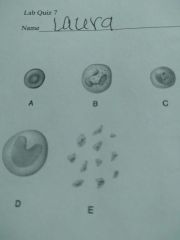
Identify the letter that indicates the formed element of the blood that is packed with molecules of hemoglobin |
A. Erythrocyte |
|
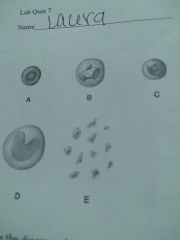
Identify the letter that indicates formed elements of the blood important in clotting |
E. Platelets |
|

Identify the letter that indicates the most abundant class of leukocyte |
B. Neutrophil |
|

Identify the letter that indicates the formed element of blood called monocyte |
D. Monocyte |
|
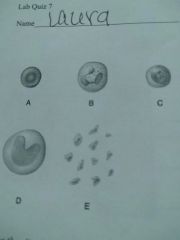
Identify the letter that indicates the formed element of blood that produces antibodies |
C. Lymphocyte |
|

Identify the letter that indicates anchor points for chordae tendinae , composed of cells from myocardium |
B. Papillary muscles |
|
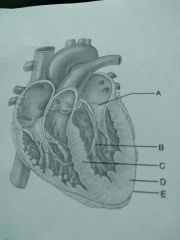
Identify the letter that indicates the tissue layer known as the epicardium |
E. |
|
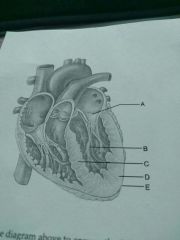
Identify the letter that indicates the left atrioventricular valve |
A. |
|
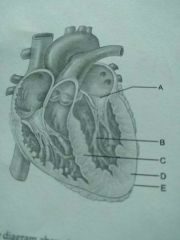
Identify the letter that indicates the location of the in her ventricular septum |
C. |
|
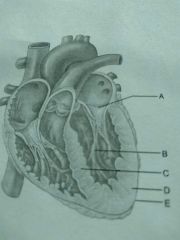
Identify the letter that indicates the location of the myocardium |
D. |
|
|
Name the Cell fragment , also called thrombocytes, involved in clotting |
Platelets |
|
|
Along with leukocytes, these contribute less than 1% of whole blood A. Lymphocytes B. Albumin C. Reticulocytes D. Erythrocytes E. Platelets |
E. Platelets |
|
|
Seen in abundance during parasitic infection 1. Erythrocytes 2. Lymphocytes 3. Eoainophil 4. Neutrophil 5. Basophil |
C. Eosinophil |
|
|
When configured blood separates into the following sequence of layers from lightest to heaviest |
Plasma, Buffy coat, hematocrit |
|
|
Heart valve with two cusps: A. Fossa ovalis B. Aortic semilunar valve C. Mitral valve D. Antriiventricular bundle E. Pmonary semilunar valve |
C. Mitral valve |
|
|
Which cell fight infection by producing antibodies A. T lymohocytes B. Plasma cell C. Eosinophil D. B lymphoctes |
D. B lymphocytes |
|
|
Name the heart chamber that receives oxygenated blood from pulmonary valves |
Left atrium |
|
|
Which of the following cells lacks mitochondrial A. Erythrocytes B. Platelets C. Neutrophils D. Basophils |
A. Erythrocytes |
|
|
Blood protein that contributes osmotic pressure , keeping water from leaking out of the vessels A. HematocritB. Buffy coatC. SerumD. AlbuminE. Myeloid |
D. Albumin D. Albumin D. Albumin D. Albumin D. Albumin |
|
|
Contraction of what structures tightens the chirdae tendinae preventing valve prolapse |
Papillary muscles |
|
|
The heart chamber that received blood from the superior vena cava inferior vena cava and coronary sinus is a. Left auricle B. Right atrium C. Right ventricle D. Left atrium E. Left ventricle |
B. Right atrium |
|
|
Which of the following vessels does not carry oxygen poor blood to the heart A. Superior vena cava B. Inferior vena cava C. Coronary sinus D. Pulmonary vein |
D. Pulmonary vein |
|
|
Fraction of blood comprised of erythrocytes A. Hematocrit B. Buffy coat C. Serum D. Albumin E. Myeloid |
A. Hematocrit |
|
|
Thread like structured of the endocardium that prevent prolapse of the av valves A. Trabeculae carnae B. Ligamentum arteriosum C. Chordae tendinae D. Fossa ovalis E. Pectinate muscle |
C. Chordae tendinae |
|
|
The region between the right and left pleural cavities is the Am pericardial cavity B. Peritoneal cavity C. Vertebral cavity D. Pulmonary cavity E. Mediastinum |
E. Mediastinum |
|
|
The hepatic portal system has two different capillary bed separated by a portal vein. What are the functions? |
The first picks up digested nutrients and the second delivers nutrients to liver cells |
|
|
Which vessel returns most of the blood from the heart to the right atrium |
Coronary sinus |
|
|
Which layer of blood vessels contain smooth muscle tissue |
Tunics media |
|
|
The semilunar valves are closed when A. Av valves closed B. Ventricles are relaxing C. Ventricles are contracting D. Atria are contracting |
B. Ventricles are relaxing |
|
|
Micro vascular are that provides nourishment to outer walls of aorta A. Tunica externa B. Subendothelial layer C. Vasa vasorum D. Tunics intima |
C. Vasa vasorum |
|
|
Wide leaky capillaries found I. Liver, bone marrow, spleen are called |
Sinusoids |
|
|
A drop of blood returning to the heart from the head region would enter the heart wall from which vessel |
Superior vena cava |
|
|
Capillaries consist of only this layer A. Tunics externa B. Tunics intima C. Vasa vasorum D. Subendothelial layer D. Tunica media |
B. Tunica intima |
|
|
The right ventricle pumps blood into which vessel |
Pulmonary trunk |
|
|
Name the coronary artery that supplies the left atrium |
Circumflex artery |
|
|
A "coming together" of alternate pathways of blood vessels A. Thoroughfare channel B. Vascular anastomoses C. Vasa vasorum D. Arterioles |
B. Vascular anastomosis |
|
|
Stenosis of the mitral valve may cause blood to back up into the A. Coronary circulation B. Pulmonary cirxulation C. Right ventricle D. Vena cava |
B. Pulmonary circulation |
|
|
Small cardiac vein is present on which chamber |
Right ventricle |
|
|
Structure that regulates blood flow into true capillaries A. Sinuskids B. Thoroughfare channel C. Fenestrations D. Metarteriole E. Precapillary sphincter |
E. Precapillary sphincter |
|
|
Which vessel in the fetus connects the pulmonary trunk to the aortic arch so that most of the blood bypasses the immature lungs A. Umbilical vein B. Ductus arteriosis C. Ductus venosis D. For a men ovale |
B. Ductus arteriosis |

